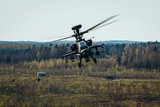AeroVironment develops 1st fully operational Hummingbird-like UAV
AeroVironment, Inc. (AV) today announced it has accomplished a technical milestone never before achieved -- controlled precision hovering and fast-forward flight of a two-wing, flapping wing aircraft that carries its own energy source, and uses only the flapping wings for propulsion and control.
The milestone was part of the Phase II contract awarded by the Defense Advanced Research Projects Agency (DARPA) to AV to design and build a flying prototype "hummingbird-like" aircraft for the Nano Air Vehicle (NAV) program.
The final concept demonstrator is called the 'Nano Hummingbird' and is capable of climbing and descending vertically, flying sideways left and right, flying forward and backward, as well as rotating clockwise and counter-clockwise, under remote control and carrying a video camera payload. During the demonstration the Nano Hummingbird flew in and out of a building through a normal-size doorway.
"The historic achievement made by the Nano Hummingbird is an example of the leading-edge innovations introduced and deployed almost routinely by the AeroVironment UAS team," said Tom Herring, AV senior vice president and general manager of Unmanned Aircraft Systems. "From the battle-proven Raven, Wasp and Puma small UAS to the tiny Nano Hummingbird to Global Observer, the largest, highest and longest flying UAS, AeroVironment continues to define the future of unmanned aircraft systems. Our mission in doing so is to provide our customers with advanced tools that help them succeed."
The hand-made prototype aircraft has a wingspan of 16 centimeters (6.5 inches) tip-to-tip and has a total flying weight of 19 grams (2/3 ounce), which is less than the weight of a common AA battery. This includes all the systems required for flight; batteries, motors, communications systems and video camera. The aircraft can be fitted with a removable body fairing, which is shaped to have the appearance of a real hummingbird. The aircraft is larger and heavier than an average hummingbird, but is smaller and lighter than the largest hummingbird currently found in nature.
"The success of the Nano Hummingbird was highly dependent on the intense combination of creative, scientific, and artistic problem-solving skills from the many AV team members, aided by a philosophy of continuous learning, which we feel was only possible due to the unique R&D environment here at AV," said Matt Keennon, AV's project manager and principal investigator on the NAV project.
The technical goals for the Phase II effort were set out by DARPA as flight test milestones for the aircraft to achieve by the end of the contract effort. The Nano Hummingbird met all, and exceeded many, of the milestones:
1. Demonstrate precision hover flight within a virtual two-meter diameter sphere for one minute.
2. Demonstrate hover stability in a wind gust flight which required the aircraft to hover and tolerate a two-meter per second (five miles per hour) wind gust from the side, without drifting downwind more than one meter.
3. Demonstrate a continuous hover endurance of eight minutes with no external power source.
4. Fly and demonstrate controlled, transition flight from hover to 11 miles per hour fast forward flight and back to hover flight.
5. Demonstrate flying from outdoors to indoors, and back outdoors through a normal-size doorway.
6. Demonstrate flying indoors 'heads-down' where the pilot operates the aircraft only looking at the live video image stream from the aircraft, without looking at or hearing the aircraft directly.
7. Fly the aircraft in hover and fast forward flight with bird-shaped body and bird-shaped wings.
Source: AeroVironment
More from Uncrewed Vehicles
-
![What's next for the Pentagon after the Replicator programme?]()
What's next for the Pentagon after the Replicator programme?
Although the Replicator initiative has made several accomplishments, there are still multiple gaps to plug across the US Department of Defense (DoD) and its services.
-
![Cummings Aerospace showcases Hellhound loitering munition designed for US Army’s LASSO programme (video)]()
Cummings Aerospace showcases Hellhound loitering munition designed for US Army’s LASSO programme (video)
Cummings Aerospace presented its turbojet-powered Hellhound loitering munition at SOF Week 2025, offering a man-portable solution aligned with the US Army’s LASSO requirements.
-
![SOF Week 2025: PDW unveils attritable FPV drone for SOF operations at scale]()
SOF Week 2025: PDW unveils attritable FPV drone for SOF operations at scale
PDW has revealed its Attritable Multirotor First Person View drone at SOF Week 2025, offering special operations forces a low-cost, rapidly deployable platform for strike and ISR missions, inspired by battlefield lessons from Ukraine.
-
![SOF Week 2025: Teledyne FLIR white paper provides guidance on reusable loitering munitions]()
SOF Week 2025: Teledyne FLIR white paper provides guidance on reusable loitering munitions
Teledyne FLIR is highlighting the emerging requirements for 'recoverable and re-usable' loitering munitions across the contemporary operating environment during this week’s SOF Week conference in Tampa, Florida.
-
![SOF Week 2025: Kraken Technology group debuts K3 Scout USV in North America]()
SOF Week 2025: Kraken Technology group debuts K3 Scout USV in North America
High-performance maritime industry player Kraken Technology Group, based in the UK, has used the SOF Week conference in Tampa, Florida this week to debut its K3 Scout uncrewed surface vessel (USV) to the North American market.
-
![Palladyne AI and Red Cat to demonstrate capabilities for autonomous drone swarms to the US military]()
Palladyne AI and Red Cat to demonstrate capabilities for autonomous drone swarms to the US military
Red Cat and Palladyne AI recently conducted a cross-platform collaborative flight involving three diverse heterogeneous drones.

























